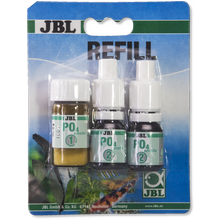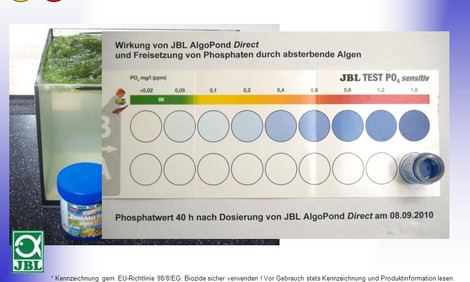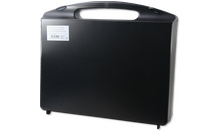Healthy aquarium/healthy pond with conditions close to nature
The right water values are dependent on the fish stock and the plants in the aquarium/pond. Even if the water looks clear it can be contaminated. With bad values diseases or algae can appear in the aquarium/pond. To maintain a healthy aquarium/pond with conditions close to nature it is important to check and adapt the water values regularly.
For each water analysis JBL provides water tests in the form of quick tests or colour change tests. These determine a certain value or several values in one go. With these water tests you can recognise algae problems and negative nitrate, nitrite, potassium, magnesium values etc.
Why test?
In an aquarium, phosphate primarily enters the water as a result of the digestive processes of the fish or in the form of food remains. In ponds, phosphate primarily enters the water as a result of leaves and dying pond plants/algae. If conditions are unfavourable, the phosphate levels may reach values that are sometimes 100 times higher, and more, than natural levels. Undesirable algae will then multiply exponentially as an inevitable consequence.
Recommended phosphate values:
Freshwater aquarium (community aquarium): 0-0.4 mg/l
Lake Malawi/Lake Tanganyika aquarium: 0-0.4 mg/l
Plant aquarium with few fish (aquascaping): 0.1-1.5 mg/l
Marine aquarium: 0-0.1 mg/l
Pond: <0.05 mg/l.
You can analyse your measured water values in the JBL Online Laboratory free of charge and receive recommendations.
JBL PO4 Phosphate Test sensitive
Quick test to determine the phosphate content in freshwater /marine water aquariums and in ponds
PROAQUATEST PO4 Phosphate Sensitive
- Determination of the optimum phosphate value for ideal plant growth or of possible cause of algae in freshwater and marine water
- Laboratory comparator system to compensate the inherent water colouring: fill glass vials with sample water, add reagents to another vial, place vials in holder, read values on colour chart
- To use: when setting up a new freshwater aquarium: once a week. With algae problems and for checking tap water
- Online Laboratory: free analysis and recommendations for the water values you have measured
- Package contents: 1 quick test, Phosphate Test PO4. Contents for approx. 50 measurements. Incl. 2 reagents, 2 glass vials, with screw cap, syringe, dosing spoon, comparator block and colour scale. Refill reagents available separately
-
Archive
 Content:50 tests
Content:50 tests -
Archive
 Content:refill
Content:refill
JBL PO4 Phosphate sensitive Test Set
Properties
| Animal species: | Arowana, Axolotl, Barbels, Bettas, Bichirs/reedfish, Blowfish, Catfish, Cichlids (South America), Corals, Crayfish, Danions, Discus, Dwarf shrimps, Flowerhorn, Gobies, Goldfish, Gouramis, Guppy, Juvenile fish, Killifish, Livebearers, Loaches, Mussels, Panchaxes, Rainbowfish, Snails, Spiny eels, Terrapins, Tetra, Tropical terrapin, Veiltails, Water turtles, freshwater butterflyfish |
| Animal size: | For all animal sizes |
| Animal age group: | All aquarium fish |
| Volume habitat: | 50 tests |
| Material: | Reagent 1: ascorbic acid, sodium chloride. Reagent 2: sulphuric acid, ammonium molybdate, purified water |
| Colour: | white / transparent |
| Dosage: | Leave one small measuring spoon reagent 1 and 10 drops reagent 2 to stand for 10 minutes |
Electronic label / illuminant
| Mercury: | No |
| Dimmable: | No |
JBL PO4 Phosphate sensitive Reagent
Properties
| Animal species: | Arowana, Axolotl, Barbels, Bettas, Bichirs/reedfish, Blowfish, Catfish, Cichlids (South America), Corals, Crayfish, Danions, Discus, Dwarf shrimps, Flowerhorn, Gobies, Goldfish, Gouramis, Guppy, Juvenile fish, Killifish, Livebearers, Loaches, Mussels, Panchaxes, Rainbowfish, Snails, Spiny eels, Terrapins, Tetra, Tropical terrapin, Veiltails, Water turtles, freshwater butterflyfish |
| Animal size: | For all animal sizes |
| Animal age group: | All aquarium fish |
| Volume habitat: | 50 tests |
| Material: | Reagent 1: ascorbic acid, sodium chloride. Reagent 2: sulphuric acid, ammonium molybdate, purified water |
| Colour: | white / transparent |
| Dosage: | Leave one small measuring spoon reagent 1 and 10 drops reagent 2 to stand for 10 minutes |
Electronic label / illuminant
| Mercury: | No |
| Dimmable: | No |
Have you lost your record sheets, already filled them all in or do you need them in another language?
With the following links you can quickly and easily print out your new record sheets with recommendations for the individual parameters at home and document the water analyses.
deutsch: https://www.jbl.de/?lang=de&mod=files&func=show&id=11164
English: https://www.jbl.de/?lang=en&mod=files&func=show&id=11164
französisch: https://www.jbl.de/?lang=fr&mod=files&func=show&id=11164
niederländisch: https://www.jbl.de/?lang=nl&mod=files&func=show&id=11164
koi carp = garden pond
angel fish = saltwater
discus = freshwater
The colour cards are not available for download on the JBL website. The absolutely accurate colour reproduction that is required can only be achieved using a printer which can be re-calibrated before each printout. Most privately used printers are not accurate enough for this.
You will find the colour chart bundle as a spare part on the respective product page and in the spare parts shop under: https://www.jbl.de/en/products/detail/8732/jbl-proaquatest-assortiment-color-chart
Only a small measuring spoon (the narrow end of the enclosed double spoon) of Reagent 1 is required.
We repeatedly receive questions regarding the symbols on the water test. The hobby areas cannot be clearly assigned to the scales for analysis. There are three symbols to make the hobby areas on the colour charts clear:
Discus = fresh water
Emperor = salt water
Koi = garden pond
In the following, you will find a list which assigns the scale for analysing the results from measurements in the hobby area and explains the symbols: The scales are described from the top to the bottom here.
NO3: salt water, fresh water, garden pond
pH 6.0 – 7.6: fresh water, garden ponds
pH 7.4 – 9.0: salt water, fresh water, garden pond
Fe: fresh water, garden pond
The following JBL tests have a uniform scale for all 2 or 3 hobby areas for analysis of the results from the measurements, as differentiation is no longer necessary:
SiO2
Cu
NH4
NO2
PO4
pH 3-10
O2
The colour charts are intended to be used with the comparator block. In addition, when the comparator block is used with the blank water sample, this compensates the inherent water colour.
Therefore, if the comparator block is not used, there will most likely be deviations in the readings.
If one of your measurements reaches the end of the colour chart scale you can multiply the scale by diluting later tests with distilled water (e.g. JBL Dest).
Here’s how to do it: dilute the sample with distilled water and carry out the test once more.
This works in detail as follows:
GH test: Instead of 5 ml use 10 ml aquarium water. Now 1 drop is equivalent to 0.5 dGH.
KH test: Instead of 5 ml use 10 ml aquarium water. Now 1 drop is equivalent to 0.5 dGH.
Note: when using 10 ml sample water the colour development is weaker with the first drops than with 5 ml sample water. Put the measuring container on a white underlay for a better readability.
NH4/NH3 ammonium/ammonia, NO2 nitrite, Fe iron and Cu copper:
2.5 ml sample + 2.5 ml dist. water: result times 2
1 ml sample + 4 ml dist. water: result times 5
0.5 ml sample + 4.5 ml dist. water: result times 10
NO3 nitrate, SiO2 silicate, PO4 phosphate sensitive and Mg magnesium freshwater:
5 ml sample + 5 ml dist. water: result x 2
2 ml sample + 8 ml dist. water: result x 5
1 ml sample + 9 ml dist. water: result x 10
PO4 phosphate koi high range:
2.5 ml sample + 2.5 ml dist. water: result x 2
1 ml sample + 4 ml dist. water: result x 5
K potassium:
7.5 ml sample + 7.5 ml dist. water: result x 2
3 ml sample + 12 ml dist. water: result x 5
1.5 ml sample + 13.5 ml dist. water: result x 10
K potassium in marine water:
1. Fill 10 ml of sample water with distilled water to 300 ml.
2. Follow the instructions for fresh water.
3. Multiply the test result by a factor of 30.
CO2 direct, Ca calcium and Mg+Ca magnesium+calcium: not required.
This is probably due to an error in use. The JBL Phosphate Test sensitive requires the following reagents:
1) 1 small level measuring spoon (narrow end of the enclosed double spoon) of reagent 1.
2) 10 drops of reagent 2.
3) Shake the sample lightly.
4) Allow 10 minutes for the colour to develop and then read the phosphate level using the comparator block.
It is important to use one small measuring spoon of Reagent 1 and not a large measuring spoon.
Basically a sealed test keeps longer than an open one. How much the shelf life is reduced depends crucially on the handling and the storage conditions of the reagents. It may happen that a reagent in a test that has been open for 9 months doesn’t indicate correctly any more. However, additional information is needed to answer this question properly.


























